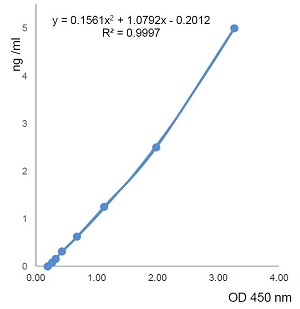Fc (human):FNDC4 (rec.)
AG-40B-0213
Protein IDQ9H6D8
Product group Proteins / Signaling Molecules
Overview
- SupplierAdipoGen Life Sciences
- Product NameFc (human):FNDC4 (rec.)
- Delivery Days Customer10
- CertificationResearch Use Only
- Concentration1 mg/ml
- Estimated Purity>95%
- Protein IDQ9H6D8
- Protein NameFibronectin type III domain-containing protein 4
- Scientific DescriptionIrisin is a recently described exercise-induced hormone secreted by skeletal muscle in mice and humans. Irisin activates beige fat cells (beige cells have a gene expression pattern distinct from either white or brown fat and are preferentially sensitive to the polypeptide hormone irisin). Irisin is cleaved from the type I membrane protein FNDC5 and improves systemic metabolism by increasing energy expenditure. FNDC4 is an ortholog of FNDC5 with 50% identity and 86% similarity compared to Irisin. FNDC4 as well as FNDC5 are extremely well conserved between species. The human FNDC4 gene is highly enriched in liver, brain tissue and adipocytes. FNDC4 is a factor with direct therapeutic potential in inflammatory bowel disease and possibly other inflammatory diseases. Recently, a new role of FNDC4 as a hepatokine has been published. Liver primarily controls the circulating levels of FNDC4 showing tight correlation with insulin sensitivity. In addition, a new orphan adhesion G protein-coupled receptor 116 (GPR116) has been identified as a receptor of FNDC4 in white adipose tissue (WAT), thereby establishing an endocrine FNDC4-GPR116 axis in the control of systemic glucose homeostasis. Moreover, the FNDC4-GPR116 axis is impaired in diabetic patients and therapeutic injections of recombinant Fc-FNDC4 into pre-diabetic mice corrected pre-diabetic hyperglycemia. - Recombinant Protein. FNDC4 (extracellular domain, human (aa 45-167) / mouse (aa 41-163)) is fused at the N-terminus to the Fc portion of human IgG1. FNDC4 extracellular domain has 100% identity between human, mouse, rat, dog and monkey. Lyophilized. Contains PBS. Irisin is a recently described exercise-induced hormone secreted by skeletal muscle in mice and humans. Irisin activates beige fat cells (beige cells have a gene expression pattern distinct from either white or brown fat and are preferentially sensitive to the polypeptide hormone irisin). Irisin is cleaved from the type I membrane protein FNDC5 and improves systemic metabolism by increasing energy expenditure. FNDC4 is an ortholog of FNDC5 with 50% identity and 86% similarity compared to Irisin. FNDC4 as well as FNDC5 are extremely well conserved between species. The human FNDC4 gene is highly enriched in liver, brain tissue and adipocytes. FNDC4 is a factor with direct therapeutic potential in inflammatory bowel disease and possibly other inflammatory diseases. Recently, a new role of FNDC4 as a hepatokine has been published. Liver primarily controls the circulating levels of FNDC4 showing tight correlation with insulin sensitivity. In addition, a new orphan adhesion G protein-coupled receptor 116 (GPR116) has been identified as a receptor of FNDC4 in white adipose tissue (WAT), thereby establishing an endocrine FNDC4-GPR116 axis in the control of systemic glucose homeostasis. Moreover, the FNDC4-GPR116 axis is impaired in diabetic patients and therapeutic injections of recombinant Fc-FNDC4 into pre-diabetic mice corrected pre-diabetic hyperglycemia.
- Storage Instruction-20°C,2°C to 8°C
- UNSPSC12352202


